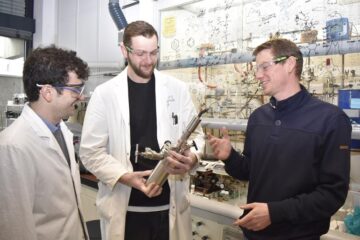In-brain monitoring shows memory network

“Previous work has focused on one region of the brain at a time,” said Arne Ekstrom, assistant professor at the UC Davis Center for Neuroscience. “Our results show that memory recall involves simultaneous activity across brain regions.” Ekstrom is senior author of a paper describing the work published Jan. 27 in the journal Nature Neuroscience.
Ekstrom and UC Davis graduate student Andrew Watrous worked with patients being treated for a severe seizure condition by neurosurgeon Dr. Nitin Tandon and his UTHealth colleagues.
To pinpoint the origin of the seizures in these patients, Tandon and his team place electrodes on the patient's brain inside the skull. The electrodes remain in place for one to two weeks for monitoring.
Six such patients volunteered for Ekstrom and Watrous' study while the electrodes were in place. Using a laptop computer, the patients learned to navigate a route through a virtual streetscape, picking up passengers and taking them to specific places. Later, they were asked to recall the routes from memory.
Correct memory recall was associated with increased activity across multiple connected brain regions at the same time, Ekstrom said, rather than activity in one region followed by another.
However, the analysis did show that the medial temporal lobe is an important hub of the memory network, confirming earlier studies, he said.
Intriguingly, memories of time and of place were associated with different frequencies of brain activity across the network. For example, recalling, “What shop is next to the donut shop?” set off a different frequency of activity from recalling “Where was I at 11 a.m.?”
Using different frequencies could explain how the brain codes and recalls elements of past events such as time and location at the same time, Ekstrom said.
“Just as cell phones and wireless devices work at different radio frequencies for different information, the brain resonates at different frequencies for spatial and temporal information,” he said.
The researchers hope to explore further how the brain codes information in future work.
The neuroscientists analyzed their results with graph theory, a new technique that is being used for studying networks, ranging from social media connections to airline schedules.
“Previously, we didn't have enough data from different brain regions to use graph theory. This combination of multiple readings during memory retrieval and graph theory is unique,” Ekstrom said.
Placing electrodes inside the skull provides clearer resolution of electrical signals than external electrodes, making the data invaluable for the study of cognitive functions, Tandon said. “This work has yielded important insights into the normal mechanisms underpinning recall, and provides us with a framework for the study of memory dysfunction in the future.”
Additional authors of the study are Chris Connor and Thomas Pieters at the UTHealth Medical School. The work was supported by the Sloan Foundation, the Hellman Foundation and the NIH.
About UC Davis
For more than 100 years, UC Davis has engaged in teaching, research and public service that matter to California and transform the world. Located close to the state capital, UC Davis has more than 33,000 students, more than 2,500 faculty and more than 21,000 staff, an annual research budget of nearly $750 million, a comprehensive health system and 13 specialized research centers. The university offers interdisciplinary graduate study and more than 100 undergraduate majors in four colleges — Agricultural and Environmental Sciences, Biological Sciences, Engineering, and Letters and Science. It also houses six professional schools — Education, Law, Management, Medicine, Veterinary Medicine and the Betty Irene Moore School of Nursing.
Additional information:
Human Spatial Cognition Lab
Media contact(s):
Arne Ekstrom, Center for Neuroscience, (530) 757-8850, adekstrom@ucdavis.edu
Rob Cahill, UTHealth Media Relations, (713) 500-3042, Robert.Cahill@uth.tmc.edu
Andy Fell, UC Davis News Service, (530) 752-4533, ahfell@ucdavis.edu
Media Contact
More Information:
http://www.ucdavis.eduAll latest news from the category: Life Sciences and Chemistry
Articles and reports from the Life Sciences and chemistry area deal with applied and basic research into modern biology, chemistry and human medicine.
Valuable information can be found on a range of life sciences fields including bacteriology, biochemistry, bionics, bioinformatics, biophysics, biotechnology, genetics, geobotany, human biology, marine biology, microbiology, molecular biology, cellular biology, zoology, bioinorganic chemistry, microchemistry and environmental chemistry.
Newest articles

Lower dose of mpox vaccine is safe
… and generates six-week antibody response equivalent to standard regimen. Study highlights need for defined markers of mpox immunity to inform public health use. A dose-sparing intradermal mpox vaccination regimen…

Efficient, sustainable and cost-effective hybrid energy storage system for modern power grids
EU project HyFlow: Over three years of research, the consortium of the EU project HyFlow has successfully developed a highly efficient, sustainable, and cost-effective hybrid energy storage system (HESS) that…

Safer alternative for an explosive reaction
The chemical industry has been using a reaction with explosive chemicals for over 100 years – now Mülheim scientists have discovered a safer alternative. The Ritter Group of the Max…





















